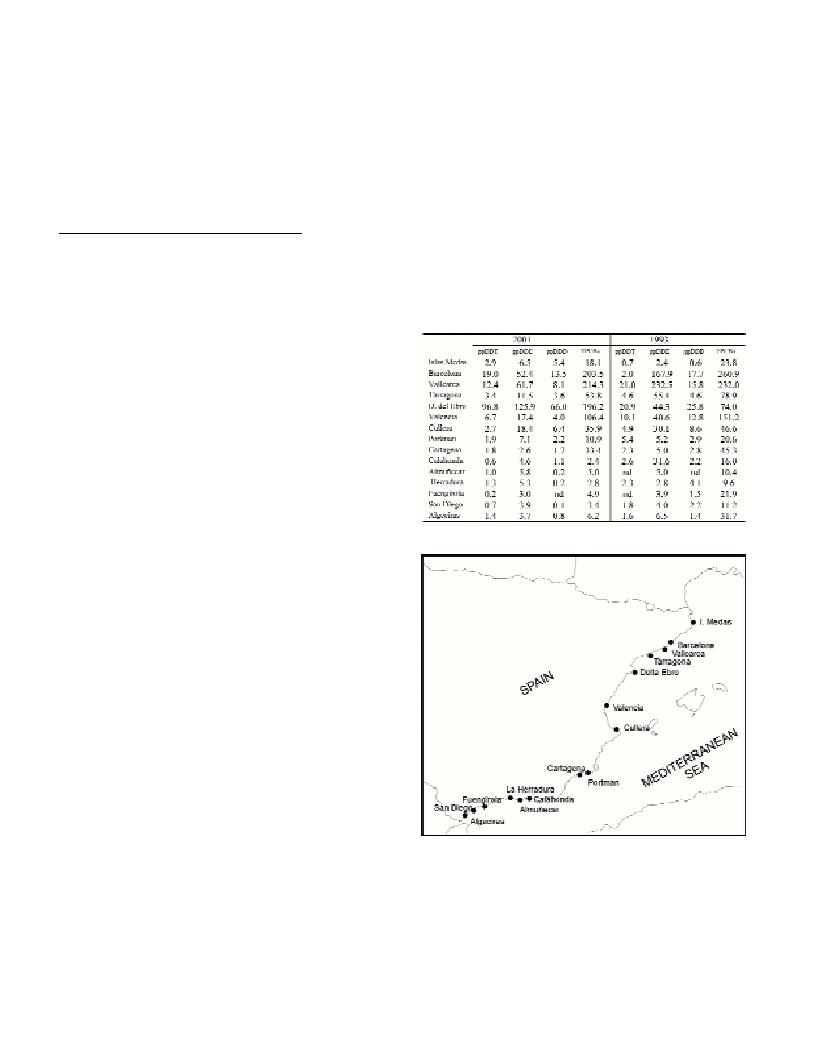COMPARISON OF ORGANIC CONTAMINANT LEVELS IN MUSSELS MYTILUS GALLOPROVINCIALIS
FROM THE MEDITERRANEAN COAST OF SPAIN COLLECTED IN 1993 AND 2001.
Juan A. Campillo
1
*, Maria Franco
2
, Fulgencio Martinez
1
And José Benedicto
1
1
Instituto Español de Oceanografía, Centro Oceanográfico de Murcia, Varadero 1, 30740 San Pedro del Pinatar, Murcia, Spain.
2
Centro Oceanográfico de Vigo. Cabo Estay. Canido. 36390 Vigo, Spain.
Abstract
Organic contaminant concentrations in mussels collected from 15 sites along the Iberian Mediterranean coast, in 1993 and 2001, are
compared applying the Sign test. Polychlorinated biphenyls (PCBs) concentrations showed a significant decrease between 1993 and 2001,
since 14 of the 15 concentrations determined in year 1993 exceed the obtained ones in 2001. DDT and its metabolites showed a comparable
decrease for ppDDD and as well as for the sum of ppDDT, ppDDE and ppDDD.
Keywords: PCB, DDT, Mytilus galloprovincialis
Rapp. Comm. int. Mer Médit., 37,2004
177
Introduction
Mussels have the ability to accumulate trace levels of certain
organic pollutants. Owing to their sedentary characteristics, bivalves
are considered ideal bioindicators for marine pollution monitoring.
Among a large number of man-made chemicals, organochlorines,
such as DDTs and PCBs, are of great concern due to their ubiquitous,
persistent and highly bioaccumulative nature as well as toxic effects.
Even though most of the countries have banned or restricted the
production and usage of many of these organochlorines, they are still
widely distributed in the marine environment (1). The objective of this
study was to assess the trendsof the levels of contamination of PCBs
and DDTs in the Mediterranean coastal waters of Spain, through
comparison of organic contaminants levels in mussels collected in
1993 and 2001.
Materials and Methods
In order to minimise natural variability, sampling was made under
standardized conditions, collecting native mussels from the same site
and at the same time of the year (May-June, post-spawning period).
Ateach site (Fig.1), three subsamples of 50 individuals, size 3 to 4
cm, were collected by hand. Preparation of samples has been
described elsewhere in detail (2). The mussel homogenates were
freeze-dried and soxhlet extracted. Lipids were removed by
chromatography over alumina. The PCBs and DDTs purified fractions
were obtained by chromatography on silica. Final extracts were
analysed by capillary gas chromatography with a
63
Ni electron
capture detector. Total PCB concentrations in samples was quantified
as the sum of 7 congeners (nº 28, 52, 101, 118, 138, 153 and 180).
Intercalibration mussel homogenate samples, from QUASIMEME,
were used as a control for the analytical methods. The Sign test was
used for comparing results obtained from 1993 and 2001.
Results and discussion.
S
PCBs and DDTs concentrations in mussels are summarized in the
Table 1. Of the 15 pairs of data per chemical, the 1993 concentrations
were higher 14, 12, 12 times for
S
PCBs,
S
DDTs and ppDDD,
respectively. Statistically,
S
PCBs results have less than a 0.1 %
chance of being random, and for
S
DDT andppDDDthere are less
than a 3 % chance that any of those tendencies toward higher values
in 1993 are random. For ppDDE and ppDDT, the Sign test does not
show any significant differences between 1993 and 2001 levels.
In 1993 and 2001,
S
PCBs mean concentration values were 68.9 and
59.8 ng/g dry wt., respectively.
S
PCBs concentration decreased a 13.2
% in 2001 with respect to 1993. In general,
S
PCBs concentrations
decreased at all the locations studied, excepted at Delta del Ebro,
where
S
PCBs concentration was 2.6 times higher in 2001 than in
1993. However, mussels collected in 2000 from this sampling point
showed a similar result obtained in 1993. Although European
countries have banned PCBs uses, releases of this compounds occur
as leaks from sealed systems, accidental losses and spills, and
emissions from PCB-containing materials and soils.
S
DDTs mean values in 1993 and 2001 were 54.6 and 39.7 ng/g dry
wt., respectively.
S
DDTs concentration decreased approximately a
27.3 %. ppDDE was the major compound founded in mussel. There is
evidence, that DDT concentration in biota have generally decreased,
whereas for related compounds no such conclusions can be drawn (3).
Conclusion
Comparison of organochlorine concentrations founded in mussel
collected in 1993 and 2001, shows a general decreases of PCBs
concentrations along the Spanish Mediterranean coast. The declining
use and progressive elimination of PCBs have been re?ected in these
results. For DDT and its metabolites, banned in many countries
including those in Western Europe, a similar decline has been
observed.
Table 1. Concentrations of PCBs and DDTs (ng/g dry wt) in mussel from
the Spanish Mediterranean Coast.
Fig. 1. Map with sampling points.
References
1-Chen W., Zhang L., Xu L., Wang X., Hong L., and Hong H.. Residues
levels of HCHs, DDTs and PCBs in shellfish from coastal areas of east
Xiamen Island and Minjiang Estuary, China. Mar. Pollut. Bull., 45: 385-
390.
2-González-Quijano A., and Fumega J., 1996. Determinación de
congéneres individuales de bifenilos policlorados en organismos marinos.
Informes Técnicos del IEO, nº 160.
3-OSPAR, 2000. Quality Status Report 2000: Region IV Bay of Biscay
and Iberian Coast.

